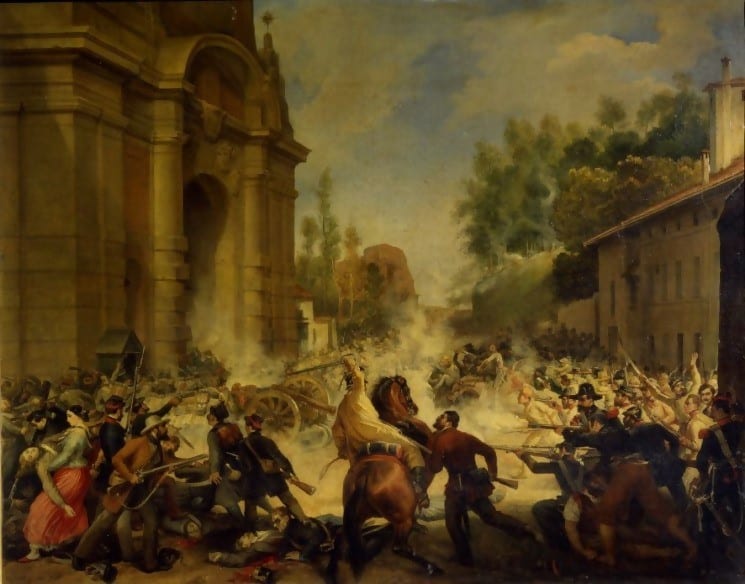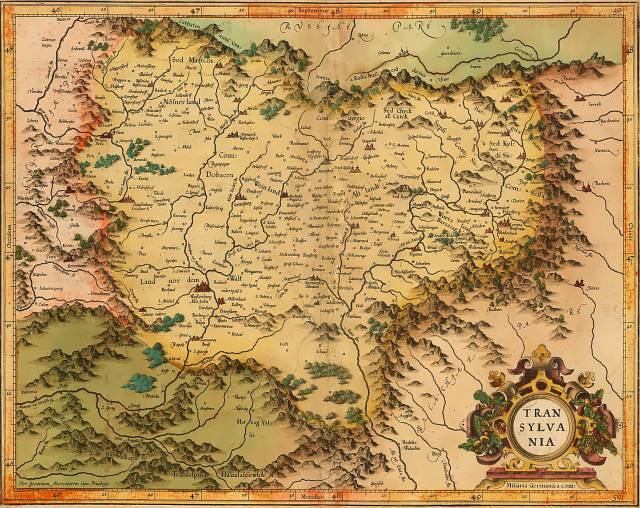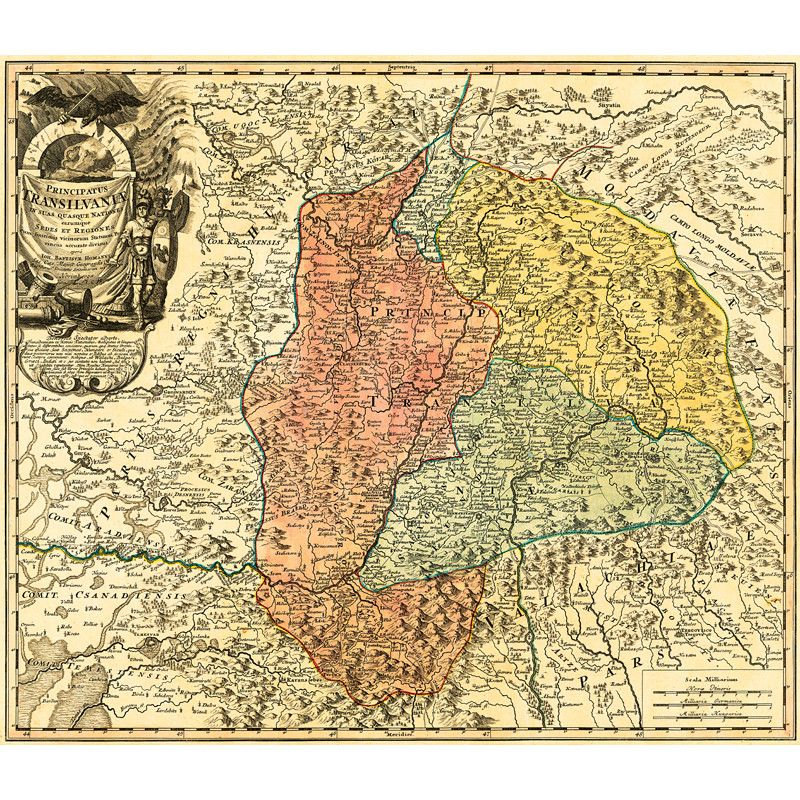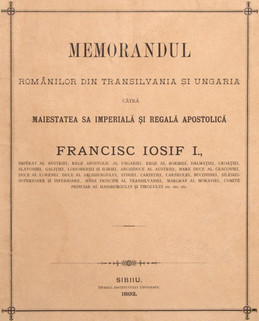
Photo 1: Dr. Ioan Rațiu's Desk Set
The 19th century is known as “the century of nations” because it was then that nationalism became the dominant ideology. This shift culminated in the liberal revolutions of 1848 which swept Europe in an effort to establish and secure freedom, national identity, and independent political life within the framework of the nation-state.
Photo 2: The 1948 European wave of revolution (Italy)
Photo 3: Map of Transylvania. Author Gerard Mercator, Amsterdam, 1610
Photo 4: Map of Transylvania in 1710
Thanks to the Habsburg Empire’s victories over the Turks at the end of the 17th Century, Transylvania, until then an autonomous principality under Ottoman suzerainty, became part of the Austrian Emperors’ possessions as the Grand Principality of Transylvania. The new arrangement was sealed by the Treaty of Karlowitz in 1699. In this world of aristocratic privilege and strict class hierarchy Romanians played virtually no political role. In the 19th century, however, the Romanian elites were determined to alter their ancillary status; the national struggle in Transylvania took various forms, from pacifist protests to memoirs and petitions, leading ultimately to civil war during the 1848 revolution.
Photo 5: The 1892 Memorandum
Photo 6: Emperor Franz Joseph I
Photo 7: Ethnographic map of Austrian monarchy, 1855
One of the most important moments in the political struggle of the Romanians in Transylvania was the so-called memorandum movement. On May 28, 1892, a formal request was submitted to Emperor Franz Joseph I in which Romanians demanded equal rights with the other nationalities of the Empire and that the policy to Hungarianize the Romanian population be abandoned. At the same time, the memorandum, as the document was styled, denounced the policies of intolerance practiced by the dual Austro-Hungarian Monarchy towards Romanians. The petition was personally handed to the Emperor by a delegation of 237 but Franz Joseph I refused to read it and instead had it sent to the Hungarian Parliament in Budapest. In turn, the Parliament did not accept the petition and returned it unopened to its authors. By that time, however, the memorandum had already been published in the press and could no longer be ignored. In retaliation, in May 1894, the signatories were accused of instigation and put on trial by the Hungarian authorities. The resulting proceedings took place in the Reduta Palace in Cluj where one of the leaders of the memorandum movement, Dr. Ioan Rațiu, uttered what would later become an immortal phrase: “What is discussed here is the very existence of the Romanian people. But one does not discuss the existence of a people, one affirms it.”
Photo 8: Dr. Ioan Rațiu

Dr. Ioan Rațiu (1828-1902) was a Transylvanian politician, a lawyer and a descendant of the old Rațiu of Noșlac (Nagylak) family from Turda, first attested at the beginning of the 14th Century, whose noble status was again confirmed by Prince Gabriel Bethlen in 1625. Rațiu attended renowned schools in Turda, Blaj and Cluj, the capital of Transylvania, and later studied theology in Pest (Hungary). The 1848 revolution was a turning point that dramatically changed his life; he returned to Transylvania where he organized, together with other leaders of the national movement, a legion that would actively fight the Hungarian revolutionary army. After the revolution, in 1850, he went to Vienna to study law. Rațiu took his doctorate in law in Pesta in 1857. He then worked as a lawyer in Budapest, Cluj and Sibiu. He became one of the founders of the Romanian National Party, the most important organization fighting for the rights of Romanians in Transylvania.

Photo 9: The authors of the 1892 Memorandum, convicted in the Reduta Palace trials
At the trial, Dr. Rațiu and the other authors of the memorandum were sentenced to terms in prison ranging from 2 months to 5 years. Although in the following year, 1893, they were all released from detention by royal amnesty, their confidence in the House of Habsburg was seriously shaken. Attesting to the great importance of this movement to this day, the Memorandum Monument sits on Cluj’s principal pedestrian avenue while a memorial plaque at the Reduta Palace reminds of the struggle for national emancipation of an entire generation.
Photo 10: Reduta Palace in Cluj
Photo 11: Memorial plaque at the Reduta Palace
Photo 12: The prison in Szeged (Hungary) where the authors of the memorandum were taken after the trials
Photo 13: Letter of thanks to Dr. Ioan Rațiu from the Romanians in Transylvania. The letter was sent to the prison in Szeged
The National Museum of Transylvanian History owns a stunning Desk Set that belonged to Dr. Ioan Rațiu, dating to the second half of the 19th Century. The objects were donated by Mrs Eugenia Rațiu, one of Ioan Rațiu’s collateral descendants, in 1984 and have both great artistic and memorial value. They are part of Romania’s national cultural patrimony.
The set is made of metal and contains an inkwell, a tampon, a candlestick, and a paper holder.

The inkwell is made of glass, with a metal base and lid, fixed on a circular support, that resembles a saucer. The saucer has an ornamented edge with a repetitive vegetal decoration delimited by transverse bands. The base of the inkwell is in profile, with a stylized twisted rope decoration. The lid is adorned with acanthus leaves arranged in semicircular registers delimited by the same transverse bands that we find on the plate. The lid has a decorative button handle with a small, circular tip.

The handled candlestick has a circular sole decorated, like the inkwell, with repetitive vegetal motifs delimited by transverse bands. The body of the candlestick resembles a goblet with a wide lip and is decorated with an egg-like motive frieze; it has a handled foot placed on a thin plate in the shape of a flower.

The wooden tampon has its upper part covered by a perforated metal lid, decorated with plant motifs and a simple, button-like handle.

The set is completed by a highly ornamented silver metal paper support, in the Rocaille style, with a putto head on top and a small metal inkwell at the base.
Text and video presentation by art historian Claudia Bonța. Film concept by Geanina Simion and Dragoș Popa. A team of The National Museum of Transylvanian History in Cluj-Napoca.
The second season of THE HISTORY OF ROMANIA IN ONE OBJECT, our online program that evokes decisive epochs in Romania's past starting from objects with powerful symbolic and representative value, is developed in partnership with two of the most important history museums in the country, Moldavia's History Museum in Iași and The National Museum of Transylvanian History in Cluj-Napoca.
#TheHistoryofRomaniainOneObject #DrIoanRatiuDeskSet



















